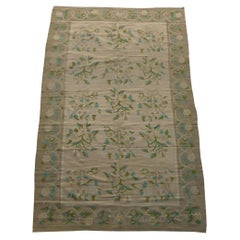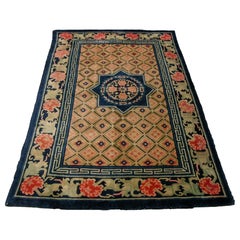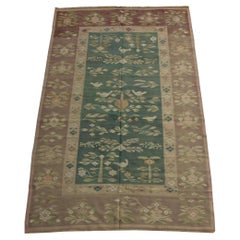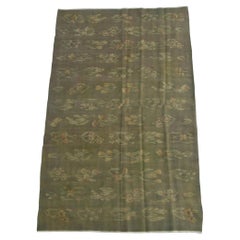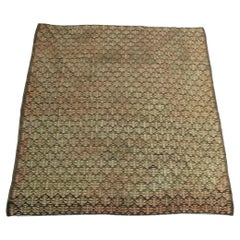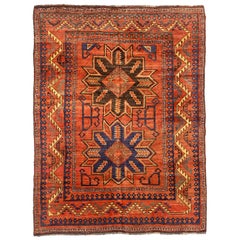Other Russian and Scandinavian Rugs
to
39
Width
to
Length
to
255
2
2
1,606
695
411
37
26
25
14
3
2
1
1
2
48
205
4
151
19
2
124
1
18
3
1
2
1
259
253
185
3
239
20
259
257
257
98
41
41
40
17
2
Style: Other
Early 20th Century Antique Kilim Floral Design Rug
Located in Los Angeles, US
Ca. 1900 Antique Kilim Floral Design Rug
Category
Early 1900s Antique Other Russian and Scandinavian Rugs
Materials
Wool, Cotton
1900s Antique Chinese Small Rug - 7'2'' X 4'5''
Located in Los Angeles, US
Antique Chinese Rugs, as opposed to most of the antique rug productions, were woven almost exclusively for internal consumption. Since they were mostly sheltered from European and We...
Category
Early 1900s Asian Antique Other Russian and Scandinavian Rugs
Materials
Wool
Early 20th Century Antique Traditional Flat Weave Bessarabian Rug
Located in Los Angeles, US
Antique Bessarabian Rugs / Kilims in both pile and tapestry weaving technique are some of the more beautiful carpets to have been produced in Europe. Many of the Bessarabian Kilims w...
Category
Early 1900s Antique Other Russian and Scandinavian Rugs
Materials
Wool, Cotton
Antique Floral Bessarabian Kilim Rug
Located in Los Angeles, US
Antique Floral Bessarabian Kilim Rug
Category
Early 20th Century Other Russian and Scandinavian Rugs
Materials
Wool, Cotton
1850s Antique Bessarabian Rug
Located in Los Angeles, US
Bessarabian Kilims and carpets are flat woven rugs that originate in the Russian provinces of the Ukraine and Moldova in the late 1800’s to the early 1900’s. While most carpet expert...
Category
19th Century Antique Other Russian and Scandinavian Rugs
Materials
Wool, Cotton
Antique Russian Area Rug Samarghand Design
Located in Dallas, TX
Antique Russian area rug handwoven from the finest sheep’s wool. It’s colored with all-natural vegetable dyes that are safe for humans and pets...
Category
20th Century Russian Other Russian and Scandinavian Rugs
Materials
Wool
$3,040 Sale Price
20% Off
Early 20th Century Antique Jerusalem Rug
Located in Los Angeles, US
Israeli Rugs – Israel is home to a surprisingly large and well-established carpet-weaving community. Area Carpet weavers in Israel had very serious traditions that were cultural, tec...
Category
Early 1900s Asian Antique Other Russian and Scandinavian Rugs
Materials
Wool, Cotton
1900 Antique Uzbek Khotan Samarkand Rug
Located in Los Angeles, US
Antique Samarkand Rugs: The desert oasis of Khotan was an important stop on the Silk Road. The people of Khotan were expert carpet weavers who produced high quality antique rugs and ...
Category
Early 1900s Uzbek Antique Other Russian and Scandinavian Rugs
Materials
Wool, Cotton
Early 20th Century Samarkand Rug
Located in Los Angeles, US
Antique Samarkand Rugs: The desert oasis of Khotan was an important stop on the Silk Road. The people of Khotan were expert carpet weavers who produced high quality antique rugs and ...
Category
Late 20th Century Other Russian and Scandinavian Rugs
Materials
Wool, Cotton
$3,359 Sale Price
20% Off
Mid 18th Century Antique Bessarabian Floral Rug
Located in Los Angeles, US
Antique Bessarabian Rugs / Kilims in both pile and tapestry weaving technique are some of the more beautiful carpets to have been produced in Europe. Many of the Bessarabian Kilims w...
Category
Early 1900s Antique Other Russian and Scandinavian Rugs
Materials
Wool, Cotton
Late-19th Century Khotan Samarkand Rug
Located in Los Angeles, US
Antique Samarkand Rugs: The desert oasis of Khotan was an important stop on the Silk Road. The people of Khotan were expert carpet weavers who produced high quality antique rugs and ...
Category
Late 19th Century Antique Other Russian and Scandinavian Rugs
Materials
Wool, Cotton
Early-19th Century Authentic Uzbek Samarkand Rug 4'8'' X 2'9''
Located in Los Angeles, US
Ca.1900 Authentic Samarkand Rug 4'8'' x 2'9'', Tribal and Traditional, Wool on cotton foundation
Category
Early 1900s Asian Antique Other Russian and Scandinavian Rugs
Materials
Wool, Cotton
Early 20th Century Antique Caucasian Hand Knotted Rug - 4'8" x 7'2"
Located in Carlstadt, NJ
Bring life to your home with this fascinating antique carpet. This handcrafted Caucasian Karachopf is an original excellent condition hand knotted oriental rug. This limited piece ha...
Category
1890s Russian Antique Other Russian and Scandinavian Rugs
Materials
Wool
$4,500 Sale Price
25% Off
Antique Collectible Woolen Needlework
Located in Los Angeles, US
Needlepoint rugs were created using the traditional needlework weaving technique that is used to make everyday items from furniture to carpets and artwork. However, it has a fascinating history both as a hobby and as an industry. When many people think of carpets, they think of pile carpets or flat weave kilims, but needlepoint has also been used to create beautiful carpets. These carpets are durable and an important part of carpet history.
Archaeologists and scholars consider the roots of needlepoint to have been around 1500 BC. They consider the first needlepoint to include the fine diagonal stitches that were used to sew tents together by the ancient Egyptians. The art eventually evolved into tapestry weaving. However, a tapestry weaving differs significantly from needlepoint in that it uses a loom and vertical warp.
Tapestry weaving is closer to the weaving of kilims and pile rugs than canvas work. However, some still include tapestry weaving in the category of needlepoint because of the fine work that appeared during the late Renaissance. It can have a similar appearance to the untrained eye. Technically, tapestry weaving and needlepoint are not the same, and they do not use the same technique.
The first actual needlepoint rugs and needle-points began to appear in the late Renaissance. Needlepoint is worked by creating stitches on a stiff canvas. The canvas is typically made from jute or linen and is quite durable. Pieces from the Renaissance were used to cover footstools, chairs, pillows, bed headboards, and other furnishings. They were also used as table coverings and wall coverings. You could also find them on many small items such as purses, shoes, and various adornments for clothing.
During the Renaissance, the craft reached a high level of skill, and the designs became incredibly detailed and realistic. They mimicked many of the subjects and styles of famous paintings of the time. They created florals, still life designs, scenes, and geometric tiled pieces. Some of them mimicked the designs found in Persian Carpets.
Needlepoint reached its peak popularity in the 19th century when it was considered a proper occupation for a lady. Needlepoint and embroidery held a similar place in societal status at the time. During this time, the work became finer, with some of the canvas reaching a high level of detail. The level of detail is determined by counting the number of mesh in an inch. During this time petit point by French needlewomen could have a mesh count as high as 45 mesh. This allowed women to create highly intricate designs with incredible levels of detail.
It is possible to find many antique pieces of needlepoint besides rugs. Needlepoint rugs were popular in France and Spain, where the technique was adapted to create highly intricate designs that mimicked the designs in architecture and fashion. They were popular because they were durable, and it could be fashioned into a variety of items. The canvases themselves were durable, and the wool that they used was also strong, which means that many of the pieces were able to withstand daily use. We have many artifacts that have survived from this time period.
Needlepoint rugs are important collectibles because they are different from the pile rugs and kilims that are typically found on the market. Needlepoint carpets are special because they take many hours to create, especially larger works. Needlepoint pieces of any type became popular throughout Europe during the 19th century. It is still a popular hobby today, but perhaps one of the most interesting stories is that of the Portuguese needlewomen of Arraiolos.
The story of these women and their beautiful carpets begins in 1492. Needlepoint was a popular occupation in Spain, which had a large population of Moors and Jews. They were an integral part of Spanish culture. However, in 1492, Queen Isabella of Spain issued a proclamation that gave these ethnic groups the order to pack their bags and board ships headed...
Category
Early 1900s Antique Other Russian and Scandinavian Rugs
Materials
Wool
Antique Samarkand Rug with Animal Print Design
Located in Los Angeles, US
Antique Samarkand Rugs: The desert oasis of Khotan was an important stop on the Silk Road. The people of Khotan were expert carpet weavers who produced high quality antique rugs and ...
Category
Early 1900s Asian Antique Other Russian and Scandinavian Rugs
Materials
Wool, Cotton
Antique Oushak Rug 15.9x12
Located in Los Angeles, US
Antique Turkish Oushak rugs have been woven in Western Turkey since the beginning of the Ottoman period. Historians attributed to them many of the great masterpieces of early Turkish...
Category
18th Century Antique Other Russian and Scandinavian Rugs
Materials
Wool, Cotton
$20,700
Antique 1920 Spanish Rug
Located in Los Angeles, US
Spanish Rugs – Although Spain is not generally thought of as a rug producing region, Spanish rugs represent the most venerable and honored tradition of rug production in Europe, goin...
Category
1920s Vintage Other Russian and Scandinavian Rugs
Materials
Wool, Cotton
$9,300
Antique Bessarabian Floral Rug
Located in Los Angeles, US
Antique Bessarabian Rugs / Kilims in both pile and tapestry weaving technique are some of the more beautiful carpets to have been produced in Europe. Many of the Bessarabian Kilims w...
Category
Early 1900s Antique Other Russian and Scandinavian Rugs
Materials
Wool, Cotton
1920s Antique Samarkand Rug
Located in Los Angeles, US
Antique Samarkand Rugs: The desert oasis of Khotan was an important stop on the Silk Road. The people of Khotan were expert carpet weavers who produced high quality antique rugs and ...
Category
1920s Vintage Other Russian and Scandinavian Rugs
Materials
Wool, Cotton
19th Century Antique Needlework Floral Rug
Located in Los Angeles, US
Needlepoint rugs were created using the traditional needlework weaving technique that is used to make everyday items from furniture to carpets and artwork. However, it has a fascinat...
Category
Early 1900s Antique Other Russian and Scandinavian Rugs
Materials
Wool, Cotton
Antique Turkmen Salor Part Silk Rug Geometric Design
Located in Los Angeles, US
Salor rug, floor covering handmade by the Salor Turkmen of Turkmenistan. Most consistent in design are the main carpets, with a quartered gul (motif) showing...
Category
Early 1900s Asian Antique Other Russian and Scandinavian Rugs
Materials
Wool, Cotton, Silk
1920s Antique Floral Samarkand Rug
Located in Los Angeles, US
Antique Samarkand Rugs: The desert oasis of Khotan was an important stop on the Silk Road. The people of Khotan were expert carpet weavers who produced high quality antique rugs and ...
Category
1920s Vintage Other Russian and Scandinavian Rugs
Materials
Wool, Cotton
Antique 1900 Samarkand Rug
Located in Los Angeles, US
Antique Samarkand Rugs: The desert oasis of Khotan was an important stop on the Silk Road. The people of Khotan were expert carpet weavers who produced high quality antique rugs and ...
Category
Early 1900s Antique Other Russian and Scandinavian Rugs
Materials
Wool, Cotton
1900s Antique Khotan Samarkand Rug
Located in Los Angeles, US
Antique Samarkand Rugs: The desert oasis of Khotan was an important stop on the Silk Road. The people of Khotan were expert carpet weavers who produced high quality antique rugs and ...
Category
Early 1900s Antique Other Russian and Scandinavian Rugs
Materials
Wool, Cotton
Early 20th Century Antique Floral Bessarabian Kilim Rug
Located in Los Angeles, US
Antique rugs that are called “Kilim rugs”, primarily refer to a type of flat weave rug that was produced without knotted pile. Because these antique rugs are found across the globe, ...
Category
Early 20th Century Other Russian and Scandinavian Rugs
Materials
Wool, Cotton
Antique Oushak Rug 8.9x7
Located in Los Angeles, US
Antique Turkish Oushak rugs have been woven in Western Turkey since the beginning of the Ottoman period. Historians attributed to them many of the great masterpieces of early Turkish...
Category
Early 1900s Antique Other Russian and Scandinavian Rugs
Materials
Wool, Cotton
$9,750
Antique 1920 Floral Samarkand Rug
Located in Los Angeles, US
Antique Samarkand Rugs: The desert oasis of Khotan was an important stop on the Silk Road. The people of Khotan were expert carpet weavers who produced high quality antique rugs and ...
Category
1920s Vintage Other Russian and Scandinavian Rugs
Materials
Wool, Cotton
1880s Antique Floral Bessarabian Rug
Located in Los Angeles, US
Antique Floral Bessarabian
Category
19th Century Antique Other Russian and Scandinavian Rugs
Materials
Wool, Cotton
Early 20th Century Antique Kilim Floral Design Rug - 12'7'' X 6'9''
Located in Los Angeles, US
Antique Bessarabian Rugs / Kilims in both pile and tapestry weaving technique are some of the more beautiful carpets to have been produced in Europe. Many of the Bessarabian Kilims w...
Category
Early 1900s Asian Antique Other Russian and Scandinavian Rugs
Materials
Wool, Cotton
19th Century Authentic European Portuguese Rug
Located in Los Angeles, US
The durability of needlepoint makes it suitable for the creation of carpets and floor coverings. The tradition of creating needlepoint rugs in Portugal has a fascinating story that b...
Category
19th Century Antique Other Russian and Scandinavian Rugs
Materials
Wool, Cotton
Antique 1920 Samarkand Rug
Located in Los Angeles, US
Antique Samarkand Rugs: The desert oasis of Khotan was an important stop on the Silk Road. The people of Khotan were expert carpet weavers who produced high quality antique rugs and ...
Category
Early 1900s Antique Other Russian and Scandinavian Rugs
Materials
Wool, Cotton
1850s Antique Central Asian Flat Weave Kilim Rug
Located in Los Angeles, US
Bessarabian Kilims and carpets are flat woven rugs that originate in the Russian provinces of the Ukraine and Moldova in the late 1800’s to the early 1900’s. While most carpet expert...
Category
19th Century Antique Other Russian and Scandinavian Rugs
Materials
Wool, Cotton
Antique Portuguese Rug 8.4x4.0
Located in Los Angeles, US
Antique PORTUGUESE Rug 8.4X4.0, handmade , traditional European style
Category
1910s Vintage Other Russian and Scandinavian Rugs
Materials
Wool, Cotton
Antique Russian Area Rug Karabagh Design
Located in Dallas, TX
Antique Russia area rug handwoven from the finest sheep’s wool. It’s colored with all-natural vegetable dyes that are safe for humans and pets. It’s a traditional Karabagh design han...
Category
20th Century Russian Other Russian and Scandinavian Rugs
Materials
Wool
$5,520 Sale Price
20% Off
Antique Russian Area Rug Shirvan Design
Located in Dallas, TX
Antique Russian area rug handwoven from the finest sheep’s wool. It’s colored with all-natural vegetable dyes that are safe for humans and pets...
Category
20th Century Russian Other Russian and Scandinavian Rugs
Materials
Wool
$3,600 Sale Price
20% Off
Hand Knotted Antique Rug Red Blue Floral Pattern Wool Russian Rug by Rug & Kilim
Located in Long Island City, NY
Originating from Russia circa 1890-1900, this antique piece connotes a Karabagh rug with a colorful approach to florals in deep, saturated hues arranged geometrically for clean arrangement. A favorite of our principal Josh Nazmiyal, the weave and design indicates Armenian characteristics lending to its collectability in equal measure to its unique use of color. This traditional style features a black background on which sit roses in pink, yellow, blue, red, and green with leaves of a bright red. Three borders appear on this antique Russian rug...
Category
1890s Russian Antique Other Russian and Scandinavian Rugs
Materials
Wool
Antique Russian Area Rug Karebagh Design
Located in Dallas, TX
Antique Russian area rug handwoven from the finest sheep’s wool. It’s colored with all-natural vegetable dyes that are safe for humans and pets. It’s ...
Category
20th Century Russian Other Russian and Scandinavian Rugs
Materials
Wool
$8,800 Sale Price
20% Off
Antique Russian Area Rug Karebagh Design
Located in Dallas, TX
Antique Russian area rug handwoven from the finest sheep’s wool. It’s colored with all-natural vegetable dyes that are safe for humans and pet...
Category
20th Century Russian Other Russian and Scandinavian Rugs
Materials
Wool
$5,520 Sale Price
20% Off
Late-19th Century Authentic Khotan Samarkand Rug
Located in Los Angeles, US
Antique Samarkand Rugs: The desert oasis of Khotan was an important stop on the Silk Road. The people of Khotan were expert carpet weavers who produced high quality antique rugs and ...
Category
Late 19th Century Antique Other Russian and Scandinavian Rugs
Materials
Wool, Cotton
Rya Rug Swedish , 1920-1950
Located in Ferrara, IT
This is a semi-antique Swedish “Rya” rug woven circa 1920 - 1950 and measures 228 x 170 CM in size. Its all-over field design is comprised of nine columns of repeating ellipse-shaped...
Category
Mid-20th Century Swedish Other Russian and Scandinavian Rugs
Materials
Wool
Early 20th Century Antique Samarkand Rug
Located in Los Angeles, US
Antique Samarkand Rugs: The desert oasis of Khotan was an important stop on the Silk Road. The people of Khotan were expert carpet weavers who produced high quality antique rugs and ...
Category
Early 1900s Antique Other Russian and Scandinavian Rugs
Materials
Wool, Cotton
1900s Antique French Needlepoint Rug
Located in Los Angeles, US
Needlepoint rugs were created using the traditional needlework weaving technique that is used to make everyday items from furniture to carpets and artwork. However, it has a fascinating history both as a hobby and as an industry. When many people think of carpets, they think of pile carpets or flat weave kilims, but needlepoint has also been used to create beautiful carpets. These carpets are durable and an important part of carpet history.
Archaeologists and scholars consider the roots of needlepoint to have been around 1500 BC. They consider the first needlepoint to include the fine diagonal stitches that were used to sew tents together by the ancient Egyptians. The art eventually evolved into tapestry weaving. However, a tapestry weaving differs significantly from needlepoint in that it uses a loom and vertical warp.
Tapestry weaving is closer to the weaving of kilims and pile rugs than canvas work. However, some still include tapestry weaving in the category of needlepoint because of the fine work that appeared during the late Renaissance. It can have a similar appearance to the untrained eye. Technically, tapestry weaving and needlepoint are not the same, and they do not use the same technique.
The first actual needlepoint rugs and needle-points began to appear in the late Renaissance. Needlepoint is worked by creating stitches on a stiff canvas. The canvas is typically made from jute or linen and is quite durable. Pieces from the Renaissance were used to cover footstools, chairs, pillows, bed headboards, and other furnishings. They were also used as table coverings and wall coverings. You could also find them on many small items such as purses, shoes, and various adornments for clothing.
During the Renaissance, the craft reached a high level of skill, and the designs became incredibly detailed and realistic. They mimicked many of the subjects and styles of famous paintings of the time. They created florals, still life designs, scenes, and geometric tiled pieces. Some of them mimicked the designs found in Persian Carpets.
Needlepoint reached its peak popularity in the 19th century when it was considered a proper occupation for a lady. Needlepoint and embroidery held a similar place in societal status at the time. During this time, the work became finer, with some of the canvas reaching a high level of detail. The level of detail is determined by counting the number of mesh in an inch. During this time petit point by French needlewomen could have a mesh count as high as 45 mesh. This allowed women to create highly intricate designs with incredible levels of detail.
It is possible to find many antique pieces of needlepoint besides rugs. Needlepoint rugs were popular in France and Spain, where the technique was adapted to create highly intricate designs that mimicked the designs in architecture and fashion. They were popular because they were durable, and it could be fashioned into a variety of items. The canvases themselves were durable, and the wool that they used was also strong, which means that many of the pieces were able to withstand daily use. We have many artifacts that have survived from this time period.
Needlepoint rugs are important collectibles because they are different from the pile rugs and kilims that are typically found on the market. Needlepoint carpets are special because they take many hours to create, especially larger works. Needlepoint pieces of any type became popular throughout Europe during the 19th century. It is still a popular hobby today, but perhaps one of the most interesting stories is that of the Portuguese needlewomen of Arraiolos.
The story of these women and their beautiful carpets begins in 1492. Needlepoint was a popular occupation in Spain, which had a large population of Moors and Jews. They were an integral part of Spanish culture. However, in 1492, Queen Isabella of Spain issued a proclamation that gave these ethnic groups the order to pack their bags and board ships headed...
Category
Early 1900s Antique Other Russian and Scandinavian Rugs
Materials
Wool, Cotton
Swedish Textile Rare 18th-Century Lion Design
Located in Ferrara, IT
This is a rare 18th-century Swedish textile that has been mounted and framed on a backing and measures 103x 48CM in size. This unique European textile ...
Category
18th Century Swedish Antique Other Russian and Scandinavian Rugs
Materials
Cotton
Rya Rug Swedish, 1950-1970
Located in Ferrara, IT
This is a vintage Swedish rug circa 1950-1970 known as a “Rya” rug which translates to simply rug and its size is 224 x 127CM. Its field makes up a back-gammon type of design with ma...
Category
Mid-20th Century Swedish Other Russian and Scandinavian Rugs
Materials
Wool
Swedish Rug Flat-weave Signed 'Karin Jonsson', 1950-1970
Located in Ferrara, IT
This Swedish Rug Flat-weave was woven in wool over cotton warp and weft by Karin Jonsson (KJ) between 1950 and 1970 measuring 222 × 168 cm (7' 3" × 5' 6"). Kilim is a Turkish term th...
Category
Mid-20th Century Scandinavian Other Russian and Scandinavian Rugs
Materials
Wool
Swedish Kilim Special Design
Located in Ferrara, IT
This is an amazing Swedish kilim woven circa 1900! It has a beautiful special design field with wool pile and cotton warp and weft. The production style of this kilim is handmade loo...
Category
19th Century Swedish Antique Other Russian and Scandinavian Rugs
Materials
Wool
Rya Rug Swedish, 1950-1970
Located in Ferrara, IT
This is a vintage Swedish “Rya” rug woven circa 1950-1970 that measures 200 x 144cm. It has a tribal field design with a center geometric diamond medallion motif enclosed within a re...
Category
Mid-20th Century Swedish Other Russian and Scandinavian Rugs
Materials
Wool
1920s Antique Needlepoint Rug - 6'7'' X 6'5''
Located in Los Angeles, US
Needlepoint rugs were created using the traditional needlework weaving technique that is used to make everyday items from furniture to carpets and artwork. However, it has a fascinating history both as a hobby and as an industry. When many people think of carpets, they think of pile carpets or flat weave kilims, but needlepoint has also been used to create beautiful carpets. These carpets are durable and an important part of carpet history.
Archaeologists and scholars consider the roots of needlepoint to have been around 1500 BC. They consider the first needlepoint to include the fine diagonal stitches that were used to sew tents together by the ancient Egyptians. The art eventually evolved into tapestry weaving. However, a tapestry weaving differs significantly from needlepoint in that it uses a loom and vertical warp.
Tapestry weaving is closer to the weaving of kilims and pile rugs than canvas work. However, some still include tapestry weaving in the category of needlepoint because of the fine work that appeared during the late Renaissance. It can have a similar appearance to the untrained eye. Technically, tapestry weaving and needlepoint are not the same, and they do not use the same technique.
The first actual needlepoint rugs and needle-points began to appear in the late Renaissance. Needlepoint is worked by creating stitches on a stiff canvas. The canvas is typically made from jute or linen and is quite durable. Pieces from the Renaissance were used to cover footstools, chairs, pillows, bed headboards, and other furnishings. They were also used as table coverings and wall coverings. You could also find them on many small items such as purses, shoes, and various adornments for clothing.
During the Renaissance, the craft reached a high level of skill, and the designs became incredibly detailed and realistic. They mimicked many of the subjects and styles of famous paintings of the time. They created florals, still life designs, scenes, and geometric tiled pieces. Some of them mimicked the designs found in Persian Carpets.
Needlepoint reached its peak popularity in the 19th century when it was considered a proper occupation for a lady. Needlepoint and embroidery held a similar place in societal status at the time. During this time, the work became finer, with some of the canvas reaching a high level of detail. The level of detail is determined by counting the number of mesh in an inch. During this time petit point by French needlewomen could have a mesh count as high as 45 mesh. This allowed women to create highly intricate designs with incredible levels of detail.
It is possible to find many antique pieces of needlepoint besides rugs. Needlepoint rugs were popular in France and Spain, where the technique was adapted to create highly intricate designs that mimicked the designs in architecture and fashion. They were popular because they were durable, and it could be fashioned into a variety of items. The canvases themselves were durable, and the wool that they used was also strong, which means that many of the pieces were able to withstand daily use. We have many artifacts that have survived from this time period.
Needlepoint rugs are important collectibles because they are different from the pile rugs and kilims that are typically found on the market. Needlepoint carpets are special because they take many hours to create, especially larger works. Needlepoint pieces of any type became popular throughout Europe during the 19th century. It is still a popular hobby today, but perhaps one of the most interesting stories is that of the Portuguese needlewomen of Arraiolos.
The story of these women and their beautiful carpets begins in 1492. Needlepoint was a popular occupation in Spain, which had a large population of Moors and Jews. They were an integral part of Spanish culture. However, in 1492, Queen Isabella of Spain issued a proclamation that gave these ethnic groups the order to pack their bags and board ships headed...
Category
1920s Vintage Other Russian and Scandinavian Rugs
Materials
Wool
19th Century European Portuguese Rug
Located in Los Angeles, US
When many people think of carpets, what comes to mind are the pile rugs and traditional kilims of the middle east. Kilims are similar to a tapestry weaving and have a flat weave, as ...
Category
19th Century Antique Other Russian and Scandinavian Rugs
Materials
Wool
Swedish Textile Lady Being Greeted by an Angel Design
Located in Ferrara, IT
Tan France auction Pick
This is an antique Swedish textile woven during the 19th century that measures 96 x 51CM in size. this textile has a ...
Category
19th Century Swedish Antique Other Russian and Scandinavian Rugs
Materials
Cotton
19th Century Vintage Samarkand Rug
Located in Los Angeles, US
Antique Samarkand Rugs: The desert oasis of Khotan was an important stop on the Silk Road. The people of Khotan were expert carpet weavers who produced high quality antique rugs and ...
Category
19th Century Antique Other Russian and Scandinavian Rugs
Materials
Wool, Cotton
19th Century Vintage Samarkand Rug
Located in Los Angeles, US
Antique Samarkand Rugs: The desert oasis of Khotan was an important stop on the Silk Road. The people of Khotan were expert carpet weavers who produced high quality antique rugs and ...
Category
19th Century Antique Other Russian and Scandinavian Rugs
Materials
Wool, Cotton
1900 Antique Animal Design Bessarabian Flat Weave Rug
Located in Los Angeles, US
Antique Bessarabian Rugs / Kilims in both pile and tapestry weaving technique are some of the more beautiful carpets to have been produced in Europe. Many of the Bessarabian Kilims w...
Category
Early 1900s Antique Other Russian and Scandinavian Rugs
Materials
Wool, Cotton
1920s Antique Needlepoint Runner
Located in Los Angeles, US
The technique for creating needlepoint rugs and other objects made from needlepoint has remained unchanged since its beginnings in the 17th century. It all begins with a canvas with ...
Category
1920s Vintage Other Russian and Scandinavian Rugs
Materials
Wool
19th Century European Portuguese Rug
Located in Los Angeles, US
When many people think of carpets, what comes to mind are the pile rugs and traditional kilims of the middle east. Kilims are similar to a tapestry weaving and have a flat weave, as ...
Category
19th Century Antique Other Russian and Scandinavian Rugs
Materials
Wool
Antique Chinese Rug with Floral Design
Located in Los Angeles, US
Antique Chinese Rugs, as opposed to most of the antique rug productions, were woven almost exclusively for internal consumption. Since they were mostly sheltered from European and We...
Category
Early 1900s Asian Antique Other Russian and Scandinavian Rugs
Materials
Wool, Cotton
Rya Rug Mid-century Gray Background Color
Located in Ferrara, IT
This is a vintage Swedish Rya runner woven during the mid-20th century circa 1950 – 1970’s and measures 334 x 115 cm in size. This runner is designed with l...
Category
Mid-20th Century Swedish Other Russian and Scandinavian Rugs
Materials
Wool
1920s Antique Needlepoint Runner
Located in Los Angeles, US
Needlepoint rugs were created using the traditional needlework weaving technique that is used to make everyday items from furniture to carpets and artwork. However, it has a fascinat...
Category
1920s Vintage Other Russian and Scandinavian Rugs
Materials
Wool, Cotton
19th Century Vintage Botanical Style Samarkand Rug
Located in Los Angeles, US
Antique Samarkand Rugs: The desert oasis of Khotan was an important stop on the Silk Road. The people of Khotan were expert carpet weavers who produced high quality antique rugs and ...
Category
19th Century Antique Other Russian and Scandinavian Rugs
Materials
Wool, Cotton
1900s Antique Indian Amritsar Rug
Located in Los Angeles, US
Antique Amritsar Rugs:
-
The spectacular rugs of Amritsar capture the exotic style of India while incorporating a subtle colonial influence. This convergence of eastern and western s...
Category
Early 1900s Asian Antique Other Russian and Scandinavian Rugs
Materials
Wool, Cotton
Other russian and scandinavian rugs for sale on 1stDibs.
Find a broad range of unique Other russian and scandinavian rugs for sale on 1stDibs. Many of these items were first offered in the 21st Century and Contemporary, but contemporary artisans have continued to produce works inspired by this style. If you’re looking to add vintage russian and scandinavian rugs created in this style to your space, the works available on 1stDibs include rugs and carpets, asian art and furniture, wall decorations and other home furnishings, frequently crafted with fabric, wool and other materials. If you’re shopping for used Other russian and scandinavian rugs made in a specific country, there are Asia, West Asia, and Caucasus pieces for sale on 1stDibs. While there are many designers and brands associated with original russian and scandinavian rugs, popular names associated with this style include and Rug & Kilim. It’s true that these talented designers have at times inspired knockoffs, but our experienced specialists have partnered with only top vetted sellers to offer authentic pieces that come with a buyer protection guarantee. Prices for russian and scandinavian rugs differ depending upon multiple factors, including designer, materials, construction methods, condition and provenance. On 1stDibs, the price for these items starts at $377 and tops out at $37,500 while the average work can sell for $4,781.
